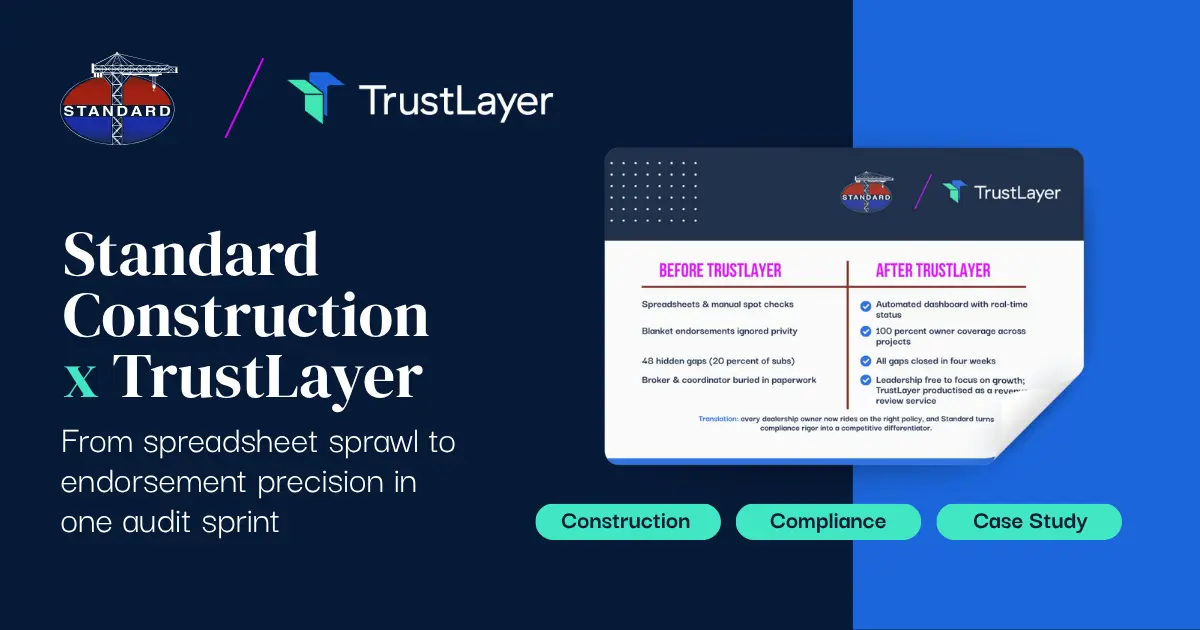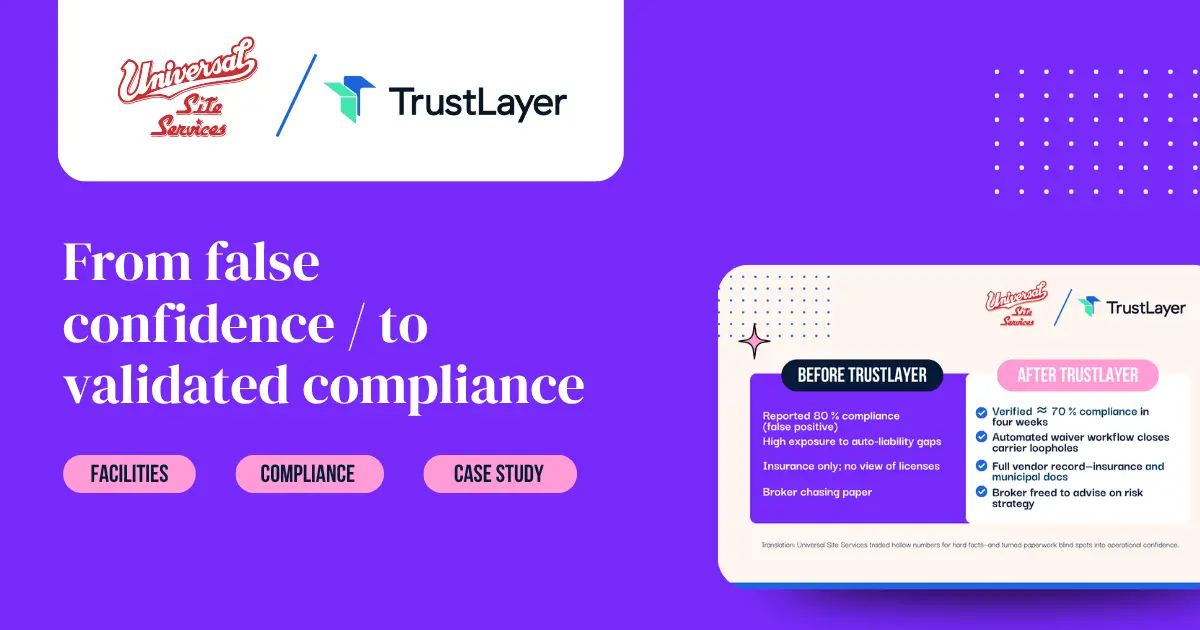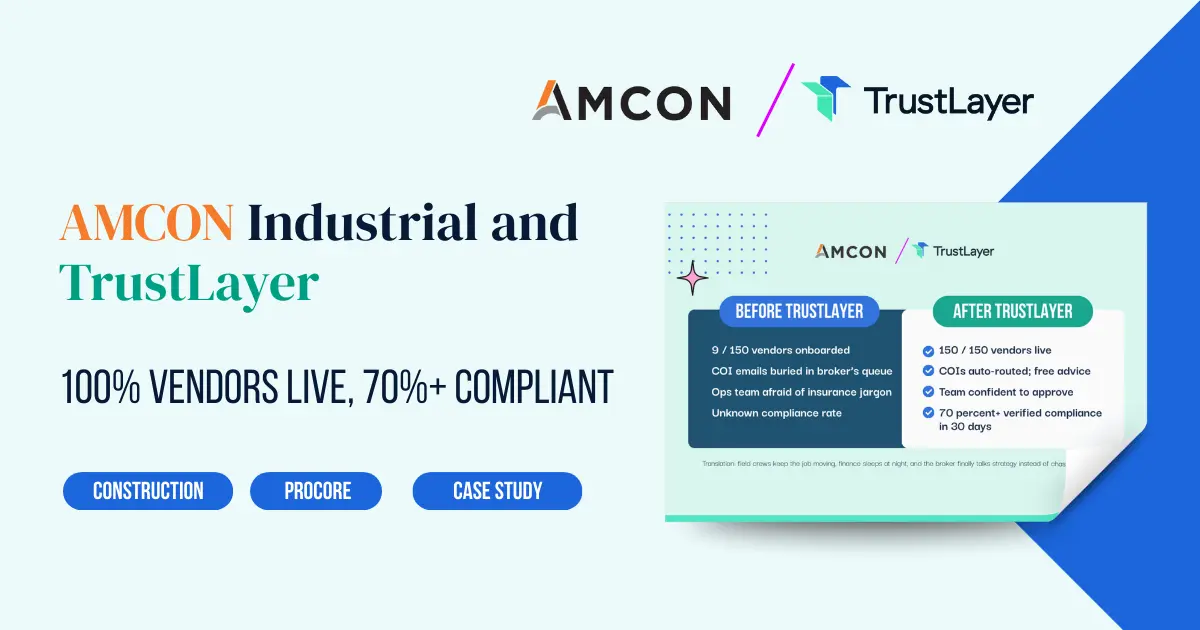Top 3 Tips For COI Tracking
In the business world, maintaining a clear and organized system for tracking Certificates of Insurance (COIs) is crucial. Whether you're a contractor, a business owner, or a project manager, understanding how to manage COIs effectively can save time, reduce risks, and ensure compliance with contractual obligations. This article will explore three crucial tips for COI tracking that can help streamline your processes and enhance your overall efficiency.
Understanding the Importance of COI Tracking
Before diving into the tips, it’s essential to understand why COI tracking is crucial for any organization. Certificates of Insurance serve as proof of insurance coverage for various parties involved in a project or business transaction. They protect against potential liabilities and ensure that all parties are adequately covered in the event of unforeseen circumstances.
Without a robust COI tracking system, businesses may face significant risks, including financial losses, legal complications, and damage to their reputation. Therefore, implementing effective strategies for COI tracking is not only beneficial but also essential for maintaining operational integrity.
Identifying Risks
One of the primary reasons for tracking COIs is to identify potential risks associated with contractors and vendors. By ensuring that all parties have valid insurance coverage, businesses can mitigate the risk of liability claims and financial losses. This proactive approach allows organizations to focus on their core operations without the looming threat of unforeseen liabilities.
Moreover, understanding the specific types of coverage that contractors hold can provide deeper insights into the nature of the risks involved. For instance, a contractor with general liability insurance may cover certain risks. However, if they lack workers' compensation insurance, the organization could still be exposed to significant liabilities in the event of an employee injury. By thoroughly reviewing and tracking these certificates, businesses can make informed decisions about which contractors to engage, ultimately leading to safer and more secure project outcomes.
Ensuring Compliance
Compliance is another critical aspect of COI tracking. Many contracts stipulate specific insurance requirements that contractors and subcontractors must meet. By maintaining an organized system for tracking COIs, businesses can ensure that all parties comply with these requirements, reducing the likelihood of disputes and fostering smoother business relationships.
Additionally, regular audits of COI documentation can help organizations stay ahead of compliance issues. This not only involves verifying the validity of the certificates but also ensuring that the coverage limits meet the contractual obligations. Organizations that take the time to review these documents periodically are better positioned to avoid penalties and maintain strong partnerships, as they demonstrate a commitment to due diligence and risk management. This proactive stance can also enhance the organization's credibility in the eyes of clients and stakeholders, reinforcing trust and reliability in business dealings.
Tip 1: Utilize Technology for Efficient Tracking
In today’s digital age, leveraging technology can significantly enhance COI tracking processes. Utilizing software solutions designed for COI management can streamline the entire process, making it easier to collect, store, and manage certificates. This not only improves accuracy but also allows organizations to maintain a comprehensive overview of their compliance status, which is crucial for risk management and operational efficiency.
Choosing the Right Software
When selecting software for COI tracking, look for features that cater to your specific needs and requirements. Many platforms offer functionalities such as automated reminders for expiring certificates, document storage, and reporting capabilities. Additionally, consider user-friendliness; a well-designed interface can facilitate quicker onboarding for staff and reduce training time. Investing in the right software can save time and reduce the chances of human error, ultimately leading to a more reliable compliance framework.
Integrating with Existing Systems
It’s also crucial to consider how the COI tracking software integrates with your existing systems. Seamless integration can enhance workflow efficiency, allowing for better collaboration between departments. For instance, integrating COI tracking with project management tools can provide real-time updates on compliance status, ensuring that all team members are informed and up-to-date. Furthermore, this integration can help in maintaining a centralized database, which not only simplifies access to vital information but also aids in auditing processes by providing a clear trail of compliance history.
Moreover, consider the software's scalability. As your organization grows, your COI tracking needs may evolve, necessitating a system that can accommodate increased volume and complexity. Some advanced platforms offer customizable features that can be tailored to specific industry requirements, allowing you to stay ahead of compliance challenges. By choosing a robust solution that can grow with your organization, you ensure that your COI management remains effective and efficient over time.
Tip 2: Establish Clear Processes and Responsibilities
Having a straightforward process for COI tracking is essential for maintaining organization and accountability. Establishing defined roles and responsibilities within your team can significantly enhance the efficiency of your tracking efforts. When everyone understands their specific tasks, it not only fosters a sense of ownership but also promotes a collaborative environment where team members can support one another in achieving common goals.
Defining Roles
Assign specific team members to oversee the COI tracking process. This can include designating someone to collect certificates, another to verify their validity, and a third to maintain the records. Clearly defined roles help ensure that nothing falls through the cracks and that every aspect of COI management is addressed. Furthermore, consider cross-training team members in different roles to create a more versatile team. This approach not only prepares your team to handle unexpected absences but also encourages a deeper understanding of the entire COI management process, leading to improved communication and problem-solving.
Creating a Standard Operating Procedure (SOP)
Developing a Standard Operating Procedure (SOP) for COI tracking can further streamline the process. An SOP outlines the steps involved in collecting, verifying, and storing COIs. This document serves as a reference point for team members, ensuring consistency and reducing the likelihood of errors. Additionally, incorporating visual aids, such as flowcharts or checklists, can enhance comprehension and make the SOP more user-friendly. Regularly reviewing and updating the SOP in response to feedback, changes in regulations, or organizational needs is also crucial. This practice not only keeps your processes relevant but also demonstrates a commitment to continuous improvement within your team.
Tip 3: Regularly Review and Update COIs
Regular reviews and updates of COIs are crucial for maintaining an accurate and up-to-date tracking system. Insurance coverage can change, and it’s essential to ensure that all certificates reflect current information. An outdated Certificate of Insurance (COI) can lead to significant risks, including financial liabilities and compliance issues, which can ultimately impact your business's reputation and operations.
Setting Review Intervals
Establishing regular intervals for reviewing COIs can help keep your records current. Depending on the nature of your business, this may be quarterly, biannually, or annually. Setting a schedule for reviews ensures that the responsibility is not overlooked and that any expired or invalid certificates are promptly addressed. Additionally, consider integrating reminders into your project management software or calendar to automate this process, making it easier to stay on top of your COI management without manual tracking.
Communicating with Contractors and Vendors
Maintaining open lines of communication with contractors and vendors is vital for effective COI management. Regularly remind them of the importance of providing updated certificates and clarify your expectations regarding insurance coverage. This proactive communication can help prevent lapses in coverage and ensure that all parties remain compliant with contractual obligations. Furthermore, consider hosting periodic meetings or workshops to discuss insurance requirements and updates, which can foster a collaborative environment and enhance understanding of the importance of maintaining current and valid Certificate of Insurance (COI) documents.
Utilizing Technology for COI Management
In today’s digital age, leveraging technology can significantly streamline the process of managing COIs. Various software solutions are available that can automate certificate tracking, send reminders for renewals, and securely store documents in the cloud. By utilizing these tools, businesses can reduce the administrative burden associated with manual tracking and minimize the risk of human error. Moreover, some platforms offer analytics features that can provide insights into coverage trends and help identify areas where additional insurance may be necessary.
Educating Your Team
Another critical aspect of effective COI management is ensuring that your team is well-informed about the importance of these documents. Providing training sessions or resources that outline the implications of inadequate insurance coverage can empower your employees to take ownership of the process. When your team understands the stakes involved, they are more likely to prioritize COI compliance and contribute to a culture of risk management within your organization. This collective effort can lead to a more resilient business framework, ultimately safeguarding your operations against unforeseen liabilities.
Conclusion
Effective COI tracking is an essential component of risk management in any business. By utilizing technology, establishing clear processes, and regularly reviewing certificates, organizations can enhance their efficiency and reduce potential liabilities. Implementing these tips can lead to a more organized and compliant approach to COI management, ultimately contributing to the success and sustainability of your business.
As the business landscape continues to evolve, staying ahead of the curve in COI tracking will not only protect your organization but also foster stronger relationships with contractors and vendors. Embrace these strategies, and watch your COI management process transform into a streamlined and effective system.
Ready to elevate your COI tracking to the next level? TrustLayer is here to revolutionize the way you manage risk. As the best-in-class COI tracker, TrustLayer is the trusted solution for hundreds of thousands of companies, streamlining the verification of compliance documents and transforming the administrative burden into a seamless, automated process. Say goodbye to the outdated methods of paper and phone calls, and embrace the future with TrustLayer's innovative technology. Our platform is designed with the modern risk manager in mind, built to validate trust quickly and efficiently. Join the ranks of industry leaders who have already discovered a better way with TrustLayer. Don't let manual processes hold you back. Set up a time to talk with our team and see how we can help you establish effective risk management practices today.
















